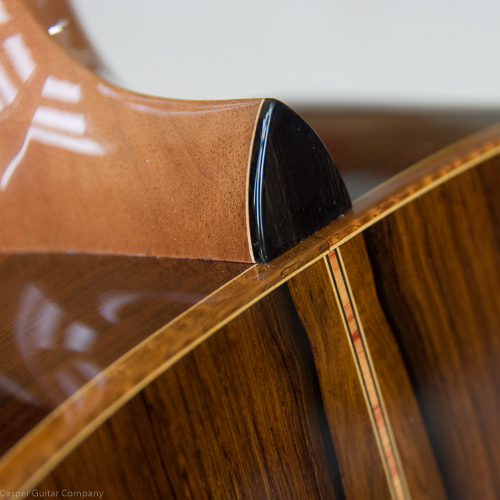Michigan – Madagascar RW w/Red Spruce top – Commission:
You asked me some time ago to give you a report on the Casper Mad Rose, and you warned me that you might put it on your website. So I send this to you with the suspicion that I am in fact writing to people who might be considering ordering a Casper guitar, and so I write to them.
To begin, my perspective—-I am 60 years old and have been playing guitar most days for 40 years. I’ve collected Martin guitars for about 40 years; I’ve switched over to Collings and luthier-built for the last 10 years. I primarily collect rosewood and koa, but I have the old Martin mahoganys as well. I play finger-style, without picks, and the guys I like are Chris Smither, John Prine, and Leo Kottke. I never play guitar in front of anybody over the age of seven.
My Casper guitar is a standard OM built in 2009 with Madagascar Rosewood (hence its name–the Mad Rose) back and sides, Adirondack Spruce top with Adirondack scalloped braces, koa binding, with an abalone and flame koarosette and an abalone torch inlay on the headstock. You can see the Mad Rose elsewhere on Ken’s website.
First, the build quality—-The woodwork is extraordinary. It’s the first thing you notice about the guitar. It’s beautiful and the more you look at it the better it gets. The joinery is perfect—better than other nationally known luthiers who charge $7-10,000 for a standard model (I know because I’m looking at one right now side by side with my Casper). The flamed koa binding is particularly well-done and lights up the rosewood. The inlay work, which Ken does himself, is spectacular (although I get some credit because I picked it all out). I particularly like Ken’s fingerboard—it’s perfect, and the neck attachment, which is a very simple bolt connection. I’ve now played 10 different Casper guitars, (Jumbos, OMs, and 00s), and each one is just stunning, and each one clearly a Casper. I have a custom Martin and a couple of custom Collings and they look machine-made next to the Mad Rose.
And the build process was interesting, too. Ken builds each guitar one at a time, and keeps asking question after question about exactly what you want and how you want it —all the while telling you exactly what he’s doing and how he’s doing it. When I saw the finished guitar, my first thought was that I had built it, not Ken, because I could see my decisions everywhere.
A couple of weeks after I got the guitar I took it up to Elderly Instruments in Lansing, Michigan and had Stretch take a look at it–check it out and tell me what he thinks. Stretch has been taking care of my guitars for years and is the best there is. Stretch looked it over and the first thing he said was “the build quality is extraordinary.”
Next, the sound—-Well, you probably already figured out that I love these guitars. Sound is so subjective (I know people who actually like Taylors) that it’s difficult to describe. You have to hear the sound for yourself—there’s no other way. But I can say this: the sound of a Casper guitar is very distinctive, and they all sound very similar, no matter the model. You can tell the sound of any Casper from any other guitar, because, I think, the build quality is so high and so consistent. The most striking thing about the sound is that it’s so balanced. The trebles are bright and full, the mids are clear and bell-like, and the bass is full and sustained. But it’s all balanced. And, of course, it’s significantly better sounding than any company manufactured guitar; Gibson, Martin, Goodall, Collings, Taylor, Larivee, etc., are not comparable to Ken’s guitars. A Casper sounds better.
One thing about the sound of the Mad Rose was that it changed dramatically over the first several weeks and months I played it. It was a really good guitar when I got it and I was delighted. But a week later it was better, and a month later it was one of the best sounding guitars I had, and now, two years later, it’s the only guitar I play.
It’s my biggest complaint about the Mad Rose: I’ve got a room full of really good guitars, and I only play the Mad Rose. That’s not supposed to happen.
And finally, the builder—-There should be no surprise here; I’ve gotten to know Ken over the past several years and he’s a great guy. He loves wood and understands how it thinks. He’s honest and fair and you can trust him. He doesn’t really care about your money; he cares about your guitar.
At this point my wife would tell me that she stopped listening to me five minutes ago.
Good-bye,
Michael
Grosse Pointe, Michigan / January 2012




